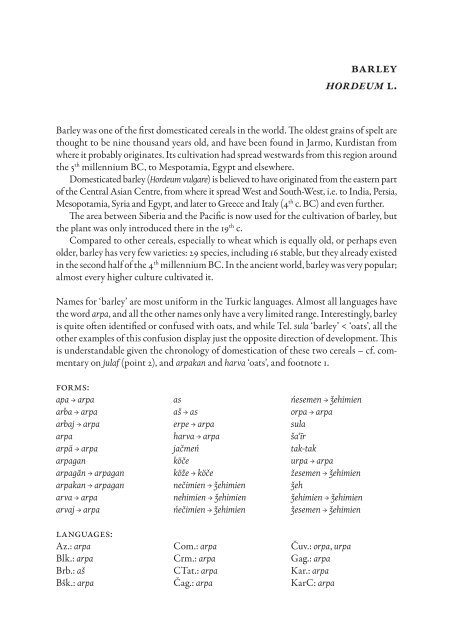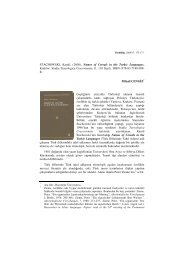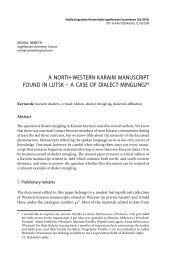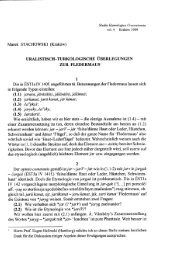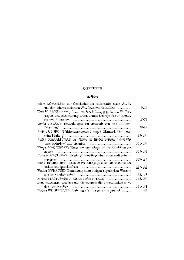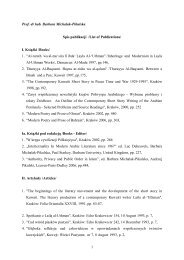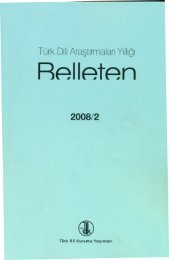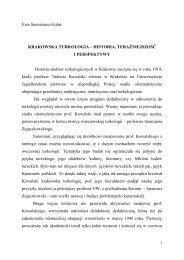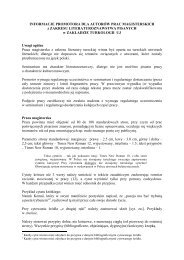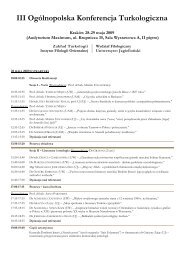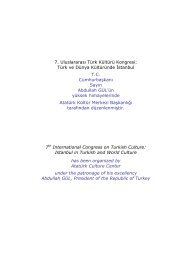Names of Cereals in the Turkic Languages - Wydział Filologiczny UJ
Names of Cereals in the Turkic Languages - Wydział Filologiczny UJ
Names of Cereals in the Turkic Languages - Wydział Filologiczny UJ
- No tags were found...
You also want an ePaper? Increase the reach of your titles
YUMPU automatically turns print PDFs into web optimized ePapers that Google loves.
arleyhordeum l.Barley was one <strong>of</strong> <strong>the</strong> first domesticated cereals <strong>in</strong> <strong>the</strong> world. The oldest gra<strong>in</strong>s <strong>of</strong> spelt arethought to be n<strong>in</strong>e thousand years old, and have been found <strong>in</strong> Jarmo, Kurdistan fromwhere it probably orig<strong>in</strong>ates. Its cultivation had spread westwards from this region around<strong>the</strong> 5 th millennium BC, to Mespotamia, Egypt and elsewhere.Domesticated barley (Hordeum vulgare) is believed to have orig<strong>in</strong>ated from <strong>the</strong> eastern part<strong>of</strong> <strong>the</strong> Central Asian Centre, from where it spread West and South-West, i.e. to India, Persia,Mesopotamia, Syria and Egypt, and later to Greece and Italy (4 th c. BC) and even fur<strong>the</strong>r.The area between Siberia and <strong>the</strong> Pacific is now used for <strong>the</strong> cultivation <strong>of</strong> barley, but<strong>the</strong> plant was only <strong>in</strong>troduced <strong>the</strong>re <strong>in</strong> <strong>the</strong> 19 th c.Compared to o<strong>the</strong>r cereals, especially to wheat which is equally old, or perhaps evenolder, barley has very few varieties: 29 species, <strong>in</strong>clud<strong>in</strong>g 16 stable, but <strong>the</strong>y already existed<strong>in</strong> <strong>the</strong> second half <strong>of</strong> <strong>the</strong> 4 th millennium BC. In <strong>the</strong> ancient world, barley was very popular;almost every higher culture cultivated it.<strong>Names</strong> for ‘barley’ are most uniform <strong>in</strong> <strong>the</strong> <strong>Turkic</strong> languages. Almost all languages have<strong>the</strong> word arpa, and all <strong>the</strong> o<strong>the</strong>r names only have a very limited range. Interest<strong>in</strong>gly, barleyis quite <strong>of</strong>ten identified or confused with oats, and while Tel. sula ‘barley’ < ‘oats’, all <strong>the</strong>o<strong>the</strong>r examples <strong>of</strong> this confusion display just <strong>the</strong> opposite direction <strong>of</strong> development. Thisis understandable given <strong>the</strong> chronology <strong>of</strong> domestication <strong>of</strong> <strong>the</strong>se two cereals – cf. commentaryon julaf (po<strong>in</strong>t 2), and arpakan and harva ‘oats’, and footnote 1.forms:apa → arpaarba → arpaarbaj → arpaarpaarpä → arpaarpaganarpagān → arpaganarpakan → arpaganarva → arpaarvaj → arpalanguages:Az.: arpaBlk.: arpaBrb.: ašBšk.: arpaasaš → aserpe → arpaharva → arpajačmeńköčeköže → köčenečimien → ǯehimiennehimien → ǯehimienńečimien → ǯehimienCom.: arpaCrm.: arpaCTat.: arpaČag.: arpańesemen → ǯehimienorpa → arpasulaša‘īrtak-takurpa → arpažesemen → ǯehimienǯehǯehimien → ǯehimienǯesemen → ǯehimienČuv.: orpa, urpaGag.: arpaKar.: arpaKarC: arpa


